Growing tomatoes is a joy for many gardeners. We love the vibrant red fruits and the sweet aroma. But, our tomato plants can get sick from diseases. This guide will help you spot and treat these problems to keep your plants healthy.
Key Takeaways
- Understand the most prevalent tomato diseases, including early blight, fusarium wilt, and bacterial spot.
- Learn to identify the distinct symptoms of each disease, such as leaf spots, wilting, and fruit damage.
- Discover preventative measures and cultural practices to minimize the risk of tomato diseases.
- Explore the role of environmental factors, such as temperature and humidity, in disease development.
- Familiarize yourself with effective treatment methods, including the use of resistant varieties and targeted fungicides.
Understanding Tomato Diseases
As avid gardeners, we know tomato plants can get sick. Each disease has its own symptoms and treatments. It’s key to spot tomato pathogens early and understand disease symptoms to keep our plants healthy.
What Are Tomato Diseases?
Tomato diseases come from fungi, bacteria, and viruses. They can harm leaves, stems, roots, and fruits. Common diseases include Anthracnose, Bacterial Canker, and more.
Importance of Early Detection
Spotting tomato disease symptoms early is crucial. Regular plant health monitoring helps us catch problems fast. Knowing the signs of disease lets us act quickly and treat our plants right.
“Regular monitoring and familiarity with common symptoms can help gardeners identify and address issues before they become severe, ensuring better crop health and yield.”
Knowing about tomato diseases and spotting them early helps us keep our plants healthy. This leads to a more successful gardening experience.
Common Fungal Diseases
Tomato plants face many fungal diseases. Each has its own symptoms and treatments. Let’s look at three major ones: late blight, early blight, and fusarium wilt.
Late Blight: Identification and Treatment
Late blight is caused by Phytophthora infestans. It shows as dark spots on leaves and fruits. These spots grow fast, killing the plant.
To fight late blight, use fungicides like chlorothalonil or mancozeb. Also, rotate crops to stop the disease from coming back.
Early Blight: Signs and Solutions
Early blight is from Alternaria linariae. It looks like small, brown spots with rings on leaves and stems. This disease weakens plants and lowers yield.
To control early blight, apply fungicides with copper or maneb. Also, make sure the soil drains well to stop the disease.
Fusarium Wilt: Prevention Measures
Fusarium wilt is from Fusarium oxysporum. It makes leaves yellow and wilt, killing the plant. To stop it, solarize or fumigate the soil.
Also, plant tomatoes with the “F” label. They are resistant to fusarium wilt.
Knowing how to spot and manage tomato fungal diseases helps keep our tomato crops healthy and productive.
Bacterial Infections in Tomatoes
Tomato growers face many challenges with bacterial diseases. Bacterial spot and bacterial canker are two major issues. Knowing the symptoms, causes, and how to control these diseases is key to a healthy tomato crop.
Bacterial Spot: Symptoms and Remedies
Bacterial spot is caused by Xanthomonas bacteria. It shows up as small, angular spots on leaves and scabby spots on fruits. These spots can greatly reduce the yield, sometimes by up to 60% in Ontario fields.
To fight bacterial spot, growers can try several things:
- Apply copper-based fungicides early
- Rotate crops to stop the disease
- Keep the area clean by removing infected plants and debris
- Avoid overhead watering to prevent bacteria spread
Bacterial Canker: Identification and Control
Bacterial canker, caused by Clavibacter michiganensis, is another big problem. It causes wilting, scorching, and bird’s-eye lesions on fruits. Infected plants may grow poorly or even collapse.
Effective ways to control bacterial canker include:
- Choose disease-resistant tomato varieties
- Use clean, certified seeds and plants
- Rotate crops for up to five years to avoid the disease
- Keep the area clean by removing infected plants and avoiding wet work
By being careful and using a variety of methods, growers can fight tomato bacterial diseases like bacterial spot and bacterial canker. This helps protect their crops and ensures a good harvest.
Viral Diseases Affecting Tomatoes
Tomato plants face many viral diseases that harm their growth and yield. Two major threats are Tomato Mosaic Virus (ToMV) and Tomato Spotted Wilt Virus (TSWV).
Tomato Mosaic Virus: Key Indicators
Tomato Mosaic Virus (ToMV) causes mottled leaves, stunted growth, and discolored fruits. It spreads through tools, debris, and human touch. Catching it early is key to prevent big losses in tomato crops.
Tomato Spotted Wilt Virus: Understanding Transmission
Tomato Spotted Wilt Virus (TSWV) also harms tomatoes. It shows as bronzing leaves, necrotic spots, and stunted growth. Thrips, a common bug, spread this virus.
Managing viral diseases in tomatoes is crucial. Growers can use resistant varieties, control bugs, and keep things clean. These steps help keep tomato plants healthy and productive.
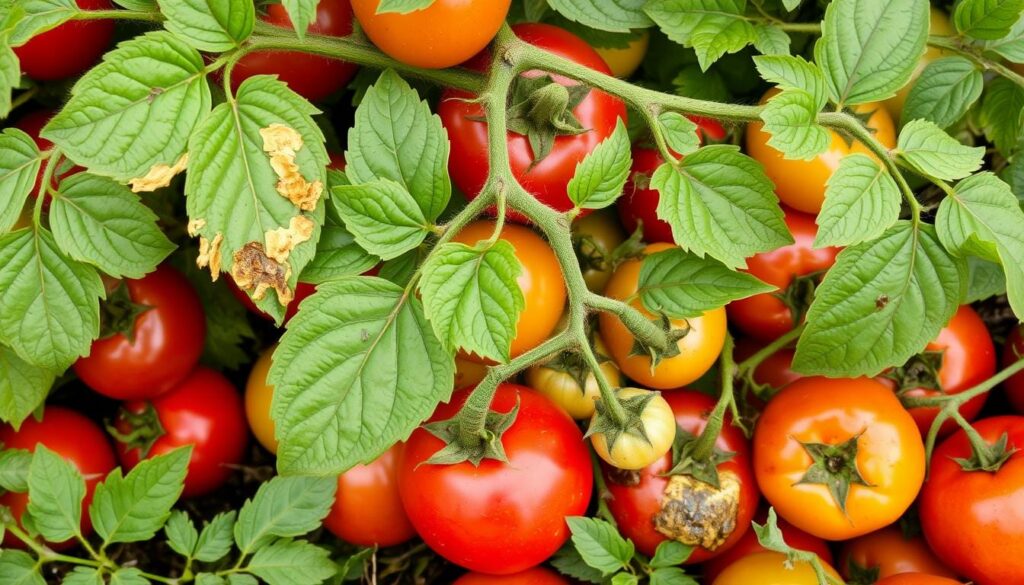
| Virus | Symptoms | Transmission |
|---|---|---|
| Tomato Mosaic Virus (ToMV) | Mottled and distorted leaves, stunted growth, fruit discoloration | Contaminated tools, infected plant debris, human contact |
| Tomato Spotted Wilt Virus (TSWV) | Bronzing of leaves, necrotic spots, stunted growth | Thrips, an insect pest |
“Viral diseases in tomatoes can have a devastating impact, but with proper management strategies, growers can mitigate the risks and maintain healthy, productive tomato plants.”
Environmental Factors Contributing to Diseases
Tomato plants face many diseases, and their growing conditions are key. Humidity and soil quality are two main factors. They affect the plant’s health and how likely it is to get sick.
Impact of Humidity on Tomato Health
High humidity is perfect for fungal and bacterial growth. These pathogens can harm tomato plants. It’s important to keep air moving and avoid watering from above.
To keep tomatoes healthy, we suggest keeping humidity levels right. Use well-ventilated areas, smart watering, and choose disease-resistant varieties. This helps fight humidity-related problems.
Role of Soil Quality in Disease Spread
Soil quality is also crucial for tomato health. Poor or compacted soil stresses plants. This weakens their defenses against diseases.
Testing and amending soil regularly is vital. This ensures it’s nutrient-rich and well-draining. A healthy soil supports the plant’s natural defenses against diseases.
“Maintaining proper growing conditions, such as managing humidity and optimizing soil health, is crucial for preventing the spread of diseases in tomato plants.”
Nutritional Deficiencies Leading to Disease
Keeping your tomato plants healthy means focusing on tomato nutrient deficiencies, soil fertility, and plant nutrition. Nutrient deficiencies can weaken plants, making them more likely to get sick.
Recognizing Nutrient Deficiencies
Some common nutrient issues in tomatoes include:
- Calcium deficiency, leading to blossom end rot
- Nitrogen deficiency, causing yellowing of older leaves
- Potassium deficiency, resulting in leaf curling and spotting
Spotting these issues early helps you fix them before disease sets in.
Optimizing Soil Nutrients for Plant Health
Testing your soil regularly is key to finding any nutrient imbalances. This ensures your tomatoes get the nutrients they need. Keeping the soil pH between 6.0 and 6.8 helps with nutrient absorption.
Using the right fertilizer, like high superphosphate and low nitrogen, helps fix deficiencies. Organic options, like those with OMRI™ certification, are also good for plant health.
By focusing on plant nutrition and fixing nutrient imbalances, your tomatoes will be healthier. A well-nourished plant can fight off diseases better.
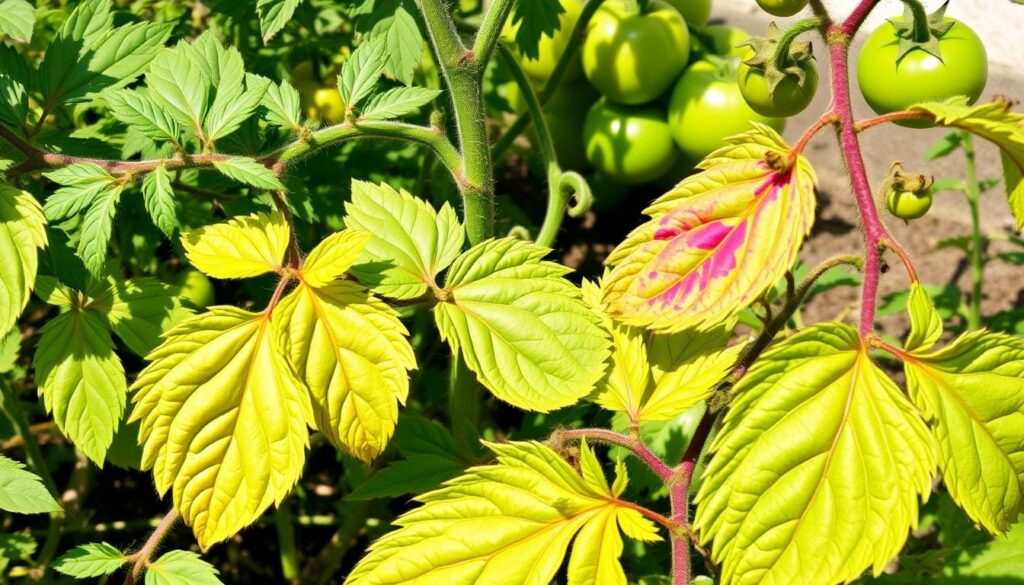
Pest-Related Tomato Diseases
Tomato plants face many pests that can harm them directly or spread diseases. Aphids, whiteflies, and thrips are common pests. Nematodes are more serious, causing root damage and nutrient loss.
Common Pests That Cause Disease
Aphids, whiteflies, and thrips spread viral diseases like Tomato Mosaic Virus. They get these viruses by sucking plant sap. Nematodes damage roots, making plants weak and more prone to diseases.
Preventative Pest Control Strategies
- Use physical barriers like insect netting or row covers to prevent pests from accessing your tomato plants.
- Implement a crop rotation plan to disrupt the life cycles of pests and diseases.
- Introduce beneficial insects, such as ladybugs, lacewings, and parasitic wasps, to naturally control pest populations.
- Practice Integrated Pest Management (IPM) techniques, including regular monitoring, targeted treatments, and cultural controls, to minimize the impact of pests and diseases.
By being proactive in pest management, you can keep your tomatoes healthy. This reduces the risk of diseases and other pest problems.
Effective Disease Management Practices
As tomato growers, we know how vital it is to keep our plants healthy. We fight against diseases with Integrated Pest Management (IPM) and crop rotation. These are key in our battle against tomato diseases.
Integrated Pest Management (IPM)
IPM is a detailed plan that uses many methods to control diseases. It includes cultural practices, biological controls, and careful use of chemicals. This approach helps us manage tomato diseases and keep our crops healthy.
Importance of Crop Rotation
Crop rotation is key to breaking disease cycles, especially those from the soil. By changing our tomato crops to unrelated plants like corn or beans for at least 3 years, we lower disease pressure. This also boosts soil health.
Using IPM strategies and crop rotation together is crucial for a healthy tomato crop. These methods work together to protect our plants and increase yields.
“Crop rotation is a fundamental strategy in organic vegetable production, as it helps to interrupt pest and disease cycles, improve soil fertility, and maintain yields over the long term.”
Utilizing Resistant Varieties
Choosing disease-resistant tomatoes can change the game in managing tomato diseases. These tomatoes are bred to fight off specific pathogens. This makes them a strong defense against common diseases. By exploring disease-resistant tomato varieties, gardeners can lower disease risks and cut down on chemical use.
Choosing Disease-Resistant Tomato Varieties
Tomato varieties with disease resistance have special codes. These codes show which diseases they can fight off. For example, V stands for Verticillium wilt, and F for Fusarium wilt. By picking the right codes for your area, your garden can stay healthy despite diseases.
Long-Term Benefits of Resistance
Using disease-resistant tomatoes in your garden has many benefits. These plants grow healthier and more, and they’re better for the environment. They also mean you use fewer chemicals, making your garden more organic and pest-free.
By using disease-resistant tomatoes, plant breeding, and genetic resistance, you can keep your tomatoes healthy for years. This is a big step towards a healthier garden.
“Resistant varieties can help suppress disease development, but should not be solely relied upon for disease control. It is important to properly integrate resistant varieties with other cultural practices and fungicides for effective disease management.”
Importance of Proper Watering Techniques
Watering your tomato plants right is key for their health and growth. Too much water can cause diseases by making the soil too wet. It can also rot the roots and wash away nutrients. To avoid these problems, using drip irrigation is a good idea.
How Overwatering Can Lead to Disease
Signs of too much water include yellow leaves and dark roots. The soil might be soggy, and the fruit could crack or rot. This makes plants more likely to get sick.
Drip Irrigation: A Preventative Approach
Drip irrigation is a top choice for watering tomatoes. It sends water straight to the roots, keeping the leaves dry. This method saves water, fights off diseases, and helps plants grow strong.
| Watering Method | Water Usage | Disease Prevention | Plant Health |
|---|---|---|---|
| Drip Irrigation | Reduced | Effective | Improved |
| Overhead Sprinklers | Increased | Less Effective | Decreased |
How often to water tomatoes depends on the weather, soil, and where you live. Watch the leaves for signs of needing water. If they droop in the evening, they need more moisture. Don’t water at night to avoid diseases.
“Proper watering encourages root growth, with the soil ideally being 6 to 8 inches moist around the stem.”
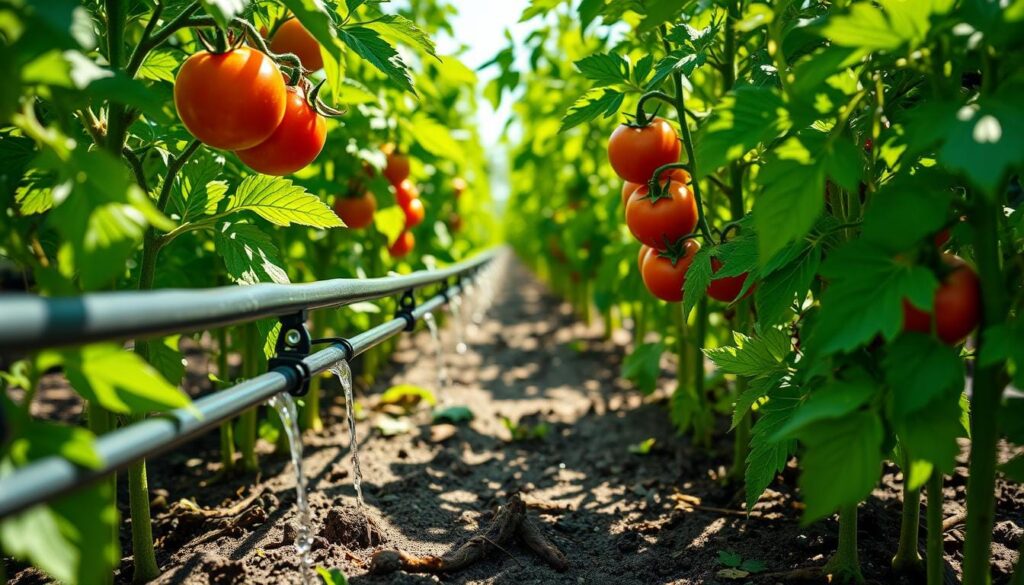
Using proper watering techniques, like drip irrigation, helps prevent disease. It promotes healthy growth and ensures a good harvest.
Role of Sanitation in Disease Prevention
Keeping your garden clean is key to stopping tomato diseases. It’s important to regularly clean and disinfect your gardening tools. Use a 10% bleach solution or rubbing alcohol to kill off harmful germs.
Cleaning Gardening Tools: Best Practices
Spending a few extra minutes to clean your tools after each use is crucial. This simple step helps stop diseases from spreading from one plant to another.
Importance of Removing Infected Plants
It’s also vital to quickly remove and destroy any infected plant material. Don’t compost diseased plants, as it can spread disease. Clear your garden of all debris at the end of the season to prevent disease carryover.
By following these sanitation steps, we can greatly lower the risk of our tomato plants getting sick. This ensures a healthy garden for many years.
“Effective sanitation greatly increases the chances of raising healthy plants.”
The Impact of Weather on Tomato Diseases
Gardeners and farmers know that weather affects tomato plants a lot. Rainfall is a big factor in tomato diseases. Too much rain helps fungal and bacterial diseases grow, causing problems for our crops.
How Rainfall Affects Disease Spread
Rain can splash pathogens onto tomato plants, spreading diseases. Wet leaves and stems are perfect for infections. For example, bacterial speck and spot diseases grow well in certain temperatures, which rain can make worse.
Best Practices for Disease Prevention in Wet Seasons
- Use raised beds or containers to improve drainage and reduce soil splashing.
- Apply a layer of mulch around the base of plants to prevent soil-borne pathogens from being splashed onto the foliage.
- Consider using row covers or hoop houses to protect your plants from direct exposure to heavy rainfall.
- Time fungicide applications before expected rainfall to help prevent disease development.
- Choose tomato varieties that are resistant to common weather-related diseases, such as early blight and septoria leaf spot.
By following these tips, we can help our tomato plants do well even in wet seasons. This ensures a good harvest and less disease impact from the weather.
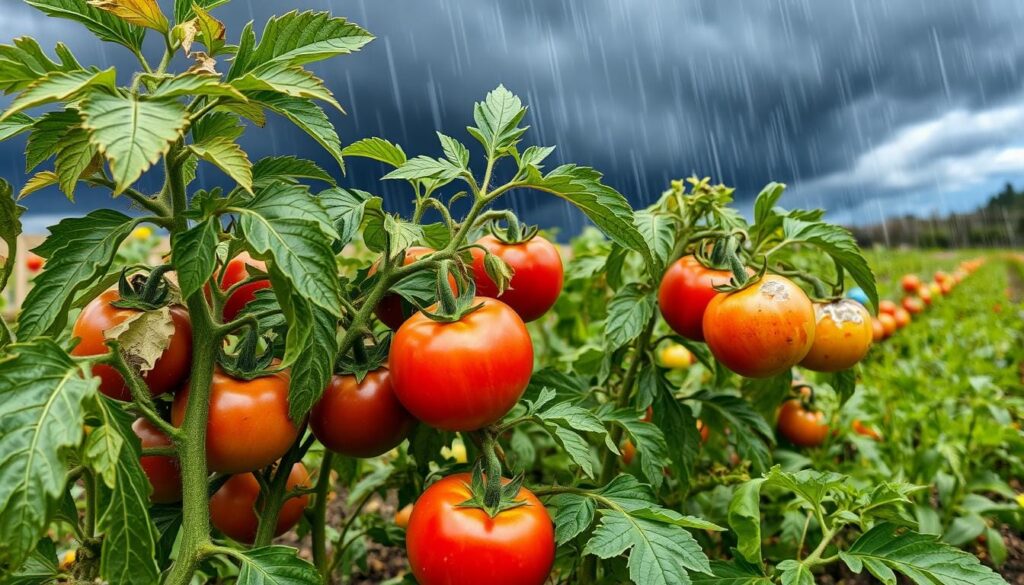
“Proper management of environmental factors, such as moisture and temperature, is crucial for maintaining the health and productivity of our tomato crops.”
Regular Monitoring of Tomato Plants
Keeping our tomato plants healthy is key to a successful garden. We must regularly check them and keep records. This way, we can spot problems early and fix them fast.
Signs to Look for During Inspections
When we check our tomato plants, we should look for certain signs. These include:
- Discoloration or spots on leaves, stems, or fruits
- Wilting or abnormal growth patterns
- Presence of insects or evidence of their activity
- Changes in the overall appearance or vigor of the plant
Inspecting leaves, stems, and fruits carefully helps us catch problems early. This way, we can stop them from getting worse.
Keeping a Garden Journal for Observations
Keeping a garden journal is also very helpful. It lets us track our observations, treatments, and weather. This helps us see patterns that might affect our plants’ health.
Acting quickly is crucial in fighting tomato diseases. By watching our plants closely and keeping detailed records, we can prevent problems. Regular checks and journaling are musts for any serious tomato grower.
Resources for Tomato Disease Management
Keeping your tomato plants healthy is key. Local Cooperative Extension Services are a great help. They offer support and advice for tomato issues.
Local Extension Services: Support and Guidance
Your local Extension Service knows a lot about growing tomatoes. They can help with soil tests, disease spotting, and treatment plans. They also have workshops and guides on tomato growing and disease control.
Recommended Reading for Tomato Growers
Local Extension Services are just the start. There are many books and journals that can help you understand tomato diseases. University guides, plant pathology journals, and gardening books are all good resources.
The Compendium of Tomato Diseases and Pests, Second Edition is a great resource. It costs $135.00 for non-APS members and $121.50 for APS members. It covers over 60 tomato diseases with nearly 250 full-color images.
By using your local Extension Service and reading good books, you can manage tomato diseases well. This will help you have a great harvest every season.
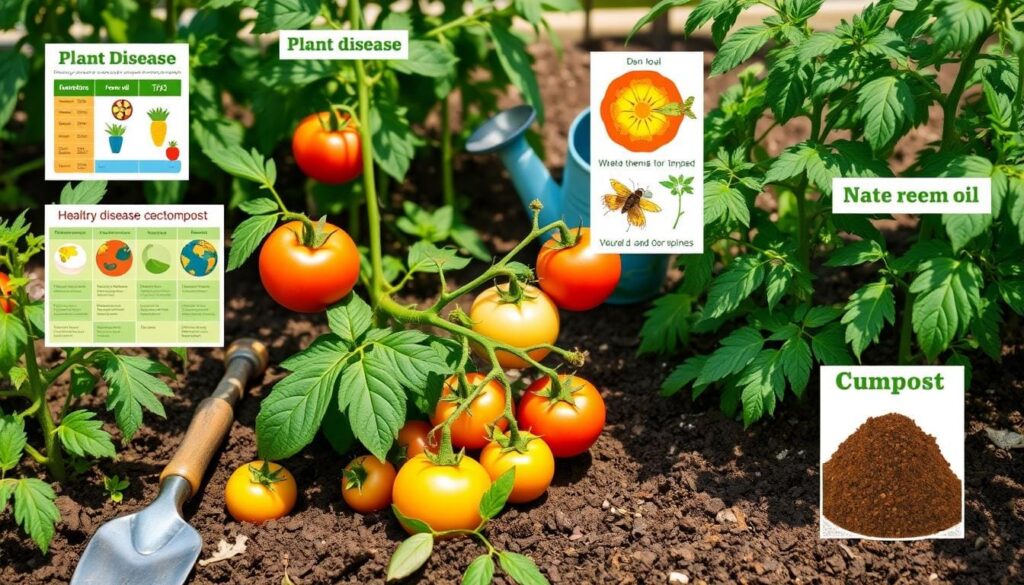
Conclusion: Maintaining Healthy Tomato Plants
To grow healthy tomato plants, we need to take several steps. We must prevent diseases, spot them early, and treat them right. By choosing the right tomato varieties, keeping our garden clean, and watering correctly, we can make our tomato plants thrive.
Recap of Key Points for Disease Prevention
Watching over our tomato plants is key. We should look for signs of disease like yellow leaves or strange spots. Keeping our garden clean and well-ventilated helps stop diseases from spreading.
Encouragement to Stay Informed and Vigilant
It’s important to know about new diseases and how to fight them. Joining gardening groups, talking to experts, and learning new things helps us stay ahead. By being alert and active, we can enjoy growing tomatoes for years to come.

